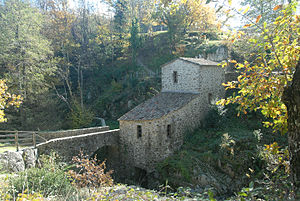Colognac
| Colognac | ||
|---|---|---|

|
|
|
| region | Occitania | |
| Department | Gard | |
| Arrondissement | Le Vigan | |
| Canton | Quissac | |
| Community association | Piémont Cévenol | |
| Coordinates | 44 ° 2 ′ N , 3 ° 49 ′ E | |
| height | 318-997 m | |
| surface | 12.3 km 2 | |
| Residents | 221 (January 1, 2017) | |
| Population density | 18 inhabitants / km 2 | |
| Post Code | 30460 | |
| INSEE code | 30087 | |
| Website | Colognac | |
 Colognac - Moulin de la Mouleyrette |
||
Colognac is a place and a multi hamlets and farmsteads community with 221 inhabitants (at January 1, 2017) in the southern French department of Gard .
location
Anglès is located approx. 28 km (driving distance) northwest of the canton capital Quissac in the southern foothills of the Cevennes at an altitude of approx. 590 m above sea level. d. M. The closest major city is Montpellier (approx. 65 km south). The climate is temperate; Rain falls throughout the year.
Population development
| year | 1800 | 1851 | 1901 | 1954 | 1999 | 2014 |
| Residents | 611 | 604 | 402 | 173 | 169 | 186 |
The continuous decline in the number of inhabitants since the middle of the 19th century is essentially due to the mechanization of agriculture and the associated loss of jobs.
economy
For centuries, the residents of the community lived on a self-sufficient basis by farming and raising livestock (sheep, goats). Today forestry and tourism are important.
history
The place is mentioned for the first time around the year 1560, ie at the beginning of the religiously motivated conflicts between Catholics and Protestants ( Huguenot Wars ). Possibly it was a place of refuge for a group of Protestants who had withdrawn into the supposed security of the mountain regions.
Attractions
- The Protestant church ( temple ) of the place was built in the 16th century; However, it was given to the Catholics after the Edict of Nantes (1598) was repealed by the Edict of Fontainebleau (1685). In 1791 it was transformed into a " Temple of Reason " and only a few years later (1794) it was brought to the cult of the Supreme Being . After the end of the revolution it was used again as a Protestant church, because only 25 of the approx. 600 inhabitants were Catholics.
- From rubble masonry watermill Moulin de la Mouleyrette the stream Coulègne is first mentioned in the 17th century, but its origins are likely to be in the Middle Ages. It was shut down around 1900 and was in serious disrepair when extensive restoration work began in 1998 (bridge) and 2002 (mill).
